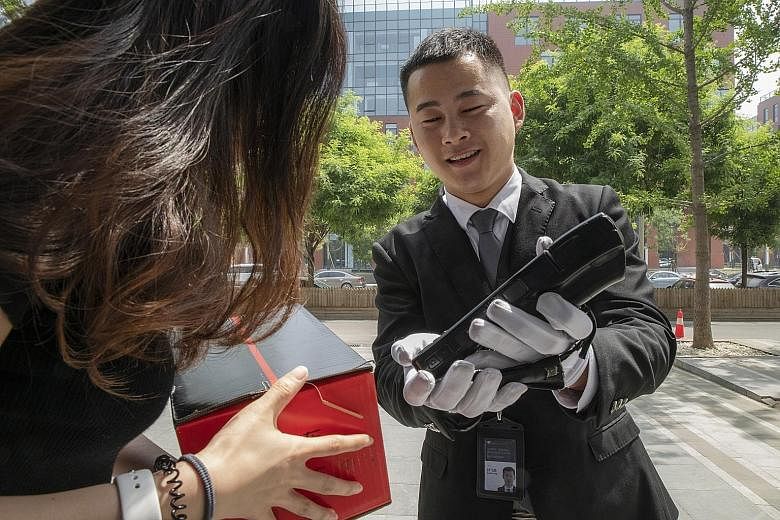HONG KONG • The Beijing delivery man who arrived with Ms Christine Lin's new silver bracelet was dressed in an elegant black suit - complete with white gloves.
He knocked on the door of her apartment holding a delicate black box tied with a golden ribbon. Handing it to Ms Lin, he asked her to confirm receipt with a fountain pen.
Inside, under layers of wrapping paper, was the US$90 (S$123) limited-edition bracelet (from a brand co-founded by Hermes International and a local designer) along with a thank-you card from JD.com, the e-commerce site that had arranged the special delivery.
"It was so ceremonial," said Ms Lin, a 23-year-old app and product designer. "Shopping on these online platforms is like enjoying a visual feast that's curated for you."
Shoppers from China accounted for one-third of global spending on luxury items last year, and Chinese luxury consumption will nearly double to 1.2 trillion yuan (S$240 billion) by 2025, from 770 billion yuan last year, consultancy McKinsey & Co estimated in a report published on April 26.
But many in China are now making those high-end purchases online, a challenge for companies that have built their businesses and the aura around their brands by coddling shoppers inside swanky stores with personal service.
The changes are forcing global luxury companies to sometimes rethink decades-old strategies and test new ones tailored to the Chinese market.
NEW STRATEGIES
Keeping China's consumers engaged is becoming critical as the economy slows amid the escalating trade war with the United States.
While the US market accounts for about 44 per cent of global online sales of luxury goods, Asia is the new growth engine of high-end brands, according to global management consultancy Bain & Co. That is why many big names in luxury are teaming up with Internet companies to offer sales and services like the white-gloved butler-style delivery that are rare in the US.
They are hoping to appeal to younger consumers just getting started buying designer jewellery, clothes or accessories.
Still, selling online carries added risks for brands which have built their lofty cachet by emphasising exclusivity.
"They don't want to be too accessible," said Mr Clement Ledormeur, general manager of 31Ten, a digital consulting agency in Shanghai.
"You can't be next to underwear or a pair of slacks."
That is one attraction of platforms dedicated to designer goods, like Alibaba Group's Tmall Luxury Pavilion, he said.
Chinese online retailer JD.com and London-based Farfetch in February announced a deal to merge JD's luxury site Toplife with Farfetch China. The agreement provides JD customers with access to the British retailer's more than 1,000 luxury brands.
CHOOSING CAUTIOUSLY
At Ralph Lauren, e-commerce sales are up across the board, but chief executive officer Patrice Louvet said he looks at online shopping with caution, carefully selecting the places that make sense for his brand to live on. In China, that includes both Tmall and JD.com.
"We're not jumping on every single opportunity out there," Mr Louvet said. But "if that's where the consumer wants to shop, that's where we need to be".
The 61.6 billion yuan that McKinsey estimates Chinese shoppers spent online on luxury goods last year is a small fraction of the total.
And customers are still mostly buying smaller items like accessories via the Internet, rather than, say, mink coats.
Yet the potential growth makes it hard for brands to sidestep digital platforms: McKinsey estimates that China's online luxury spending will more than double to 147 billion yuan by 2025.
High-end brands hope other benefits will override the challenges of selling online in the country, and they're hopping in en masse.
Louis Vuitton, which runs its own e-commerce site for China, this month launched an official account on social commerce site Xiaohongshu, or Little Red Book, to promote its brand with Chinese consumers.
Brands such as Alexander McQueen, Burberry and Saint Laurent have teamed up with Chinese firms to expand their digital footprints.
BETTER THAN STORES?
Opening physical stores requires a city to have existing luxury shopping streets, where fancy fashion labels are sold.
But many Chinese cities do not have that infrastructure, making it easier to build an online store for those new markets, said Mr Fabrizio Freda, chief executive officer of Estee Lauder.
Tom Ford, one of Estee Lauder's most popular brands, is in 10 Chinese cities only because the key to expansion is to work with Alibaba's Tmall rather than try to open stores across the country.
"In China, there are about 600 cities with millions of inhabitants where there is no physical distribution but there's interest, desire and aspiration for high-quality products," said Mr Freda. "Tmall is the answer to that."
Alibaba's Tmall marketplace launched Luxury Pavilion in 2017 and now has more than 100 brands, including DKNY and Versace.
The company wants to double the number of brands by next March, and is trying to keep the platform exclusive by offering features such as three-dimensional images of products and physical stores, said Ms Jessica Liu, Tmall's general manager of fashion and luxury.
BLOOMBERG

